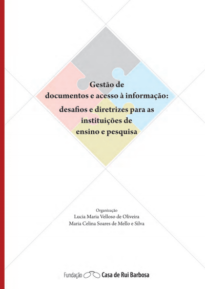-
Desafios do acesso contextualizado: identificação e relação orgânica entre documentos de Ciência e Tecnologia
- Voltar
Metadados
Miniatura

Título
Desafios do acesso contextualizado: identificação e relação orgânica entre documentos de Ciência e Tecnologia
Relacionado à Obra
Organizador(es)
OLIVEIRA, Lúcia Maria Velloso de | SILVA, Maria Celina Soares de Mello e
Natureza
ISSN ou ISBN
978-85-7004-333-7
Link do Livro
http://site.mast.br/encontro_arquivos_cientificos/pdf/setimo_encontro_de_arquivos_cientificos.pdf
ISBN
978-85-7004-333-7
Páginas
171-182
Ano
Observações
Texto apresentado no VII Encontro de Arquivos Científicos, de 24 a 26 de junho de 2015.
Categoria
Local
Outro Idioma
Title/Título/Titre
Contextualized Access challenges: identification and organic relationship between Science & Technology documents
Abstract/Résumé/Resumen
This article aims to question and discuss the various aspects related to the preservation of documentary heritage of the area of Science and Technology, in order to deepen the discussion on methodologies and criteria to manage documents from Metallography Section of the Institute of Technological Research State of São Paulo (IPT) in order to identify, organize, and make them available for research, both technical and scientific. The process of identifying Science & Technology files, with a view to organizing, managing and back access, largely for historical research, represents a challenge to be faced, especially when it takes into account the multiplicity of settings documentary and the three-dimensional records from the company’s core activity. This work is destined to share experiences about the activities that have been developed in that document archive, with documents ranging from the years 1907 to 1960 and that currently are allocated in the Laboratory of Corrosion and Protection, situated in the Center for Metallurgical and Materials Technologies (LCP/CTMM). The introduction of microscopic metallography in Brazil started in 1907with the installation of a laboratory in the Resistance of Materials Department (GRM) of the Polytechnic School in 1934.Themetallographyworksaimed the quality control of the metal components used in the construction and in the railways. The metallography technique was consolidated in Brazil as an important teaching tool and industrial development, especially in cases of failure analysis, quality control, reverse engineering and microstructural optimization through thermo mechanical treatments. In the 1950sthe whole experience of the Metallography Section in microstructures and heat treatment of metallic materials provided support to the emerging Brazilian automotive industry in the development of national components for foreign automakers in Brazil. Thus, it highlights the importance of the documents in question, because they reveal certain social, economic and cultural aspects of society and for which they were produced or used, as well as the scientific advances through which they arise. All this action research and technology development produced documentary records of functional and unique historical value, resulting in a collection that – in addition to traditional textual documents – contain iconographic and three-dimensional documents whose organic relations are given emphasis in this work.





